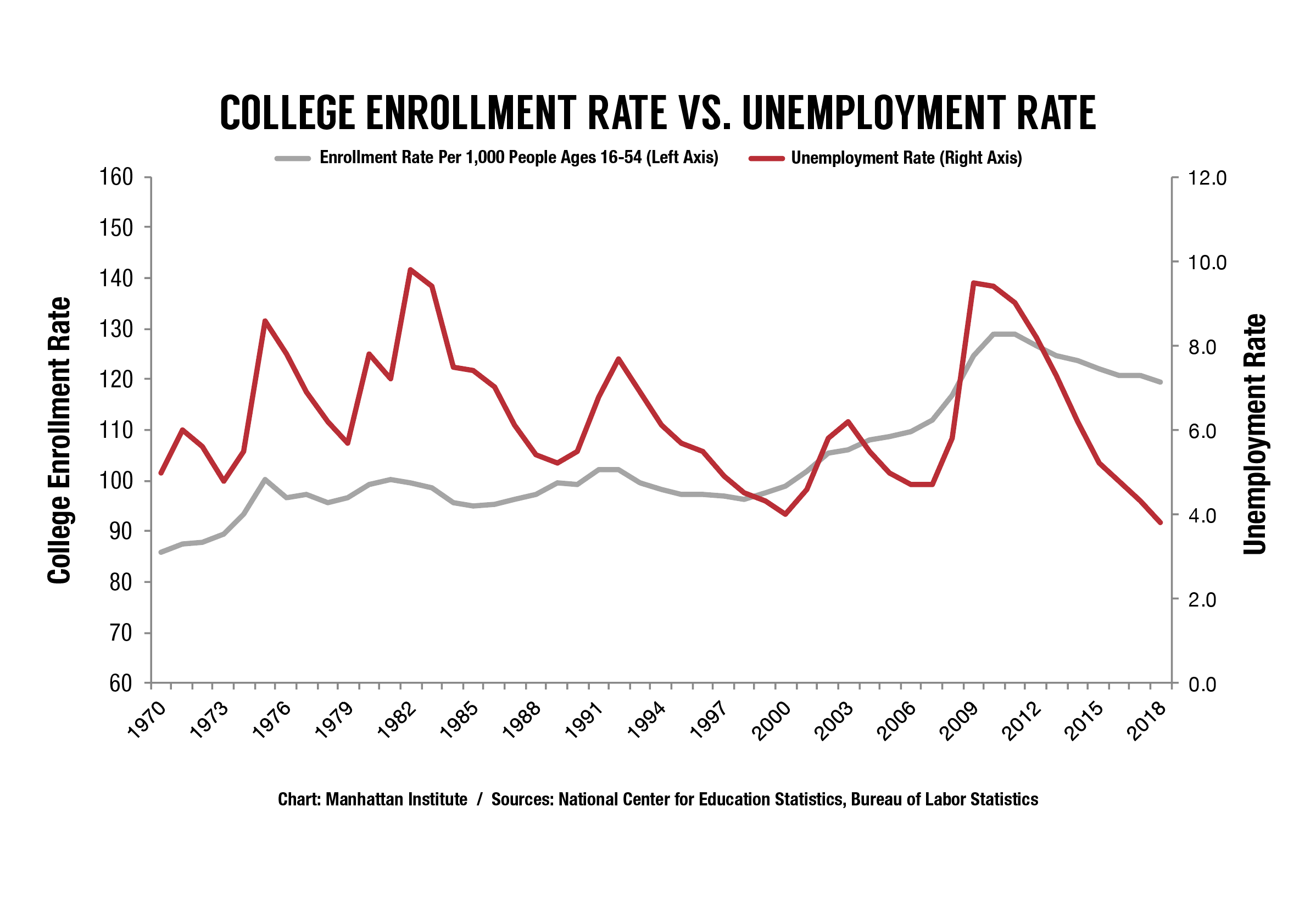The Ripple Effect: How Enrollment Decline Impacts College Town Economies

Table of Contents
The Direct Impact on Local Businesses
Enrollment decline directly impacts the financial health of businesses heavily reliant on the student population. This effect manifests in two primary ways: reduced spending power and subsequent job losses.
Reduced Spending Power
Fewer students translate to significantly less disposable income circulating within the local economy. Businesses such as restaurants, bookstores, coffee shops, and entertainment venues – all staples of the college town experience – feel this impact acutely. Reduced demand leads to decreased sales, shrinking profit margins, and, ultimately, potential business closures. For example, a popular pizza place near campus might see a 20% drop in sales if enrollment falls by a similar percentage, directly impacting their ability to pay rent, staff, and suppliers.
- Decreased demand for student housing: Vacant apartments and dorms directly impact rental income for landlords.
- Lower sales in retail stores catering to students: Clothing stores, tech shops, and convenience stores experience reduced foot traffic and revenue.
- Reduced revenue for campus-related services: Printing services, tutoring centers, and other student-focused businesses suffer reduced income.
Loss of Jobs
As local businesses struggle with reduced revenue due to enrollment decline, they are often forced to make difficult choices, including staff reductions. This leads to increased unemployment within the college town, impacting both full-time and part-time employees. The loss of part-time student jobs further exacerbates the financial strain on both the students and the overall local economy.
- Job losses in the service sector: Restaurants, bars, and retail stores are particularly vulnerable.
- Reduced opportunities for graduate assistantships and research positions: Fewer students mean fewer research projects and less need for support staff.
- Impact on local property values and taxes: Reduced economic activity can lead to lower property values and decreased tax revenue.
The Indirect Impact on the Broader Economy
The effects of enrollment decline extend far beyond the immediate impact on local businesses, indirectly affecting the broader economic health of the college town.
Reduced Tax Revenue
A shrinking student population directly translates to lower tax revenue for the local government. This reduction comes from several sources. Fewer students mean less property tax revenue from student housing and university-owned property. Simultaneously, decreased consumer spending leads to a drop in sales tax revenue. This combined impact reduces funding for essential public services, impacting the quality of life and potentially hindering future economic development.
- Impact on local government budgets and public services: Cuts to schools, infrastructure, and public safety are possible.
- Potential for increased property taxes on other residents to compensate: This can create resentment and further strain the local community.
- Reduced funding for community projects and improvements: Economic hardship limits investment in community infrastructure.
Decreased Property Values
Lower student enrollment leads to a decrease in the demand for housing near the university. This reduced demand directly impacts property values, affecting homeowners and the overall local tax base. Furthermore, the decline in economic opportunity can trigger a "brain drain," as young professionals and families seek better prospects elsewhere. This further weakens the local economy and hampers its long-term growth potential.
- Negative impact on the real estate market: Lower demand drives down property prices.
- Difficulty attracting new businesses and investment: A struggling economy is less attractive to potential investors.
- Long-term economic stagnation: The cumulative effect can lead to a cycle of decline that's difficult to break.
Strategies for Mitigation and Growth
While the challenges posed by enrollment decline are significant, proactive strategies can mitigate the negative impacts and foster sustainable economic growth in college towns.
Attracting and Retaining Students
Investing in the university and the college town experience is crucial to attracting and retaining students. This requires a multifaceted approach.
- Investing in innovative academic programs and facilities: Offering cutting-edge programs and modern facilities can attract top students.
- Improving student support services and campus life: A supportive campus environment is crucial for student success and retention.
- Offering competitive financial aid packages: Making higher education more affordable is key to attracting a diverse student body.
- Promoting the unique qualities and advantages of the college town: Highlighting the town's cultural attractions and opportunities can attract prospective students.
- Marketing campaigns targeting prospective students: Effective marketing is crucial to raising awareness and attracting prospective students.
- Partnerships with local businesses to offer student discounts: Incentivizing students to support local businesses.
- Development of new student housing options: Meeting the demand for modern and affordable student housing.
Diversifying the Economy
Relying solely on the student population for economic vitality is a risky strategy. College towns must diversify their economies to ensure long-term stability and resilience.
- Attracting businesses that are not solely reliant on the student population: This might include businesses targeting the broader community or regional markets.
- Developing a robust tourism industry to supplement the local economy: Promoting local attractions and cultural heritage can attract visitors.
- Supporting entrepreneurship and innovation: Creating a supportive environment for startups and small businesses can generate new jobs and economic activity.
- Investing in infrastructure improvements to attract businesses: Modern infrastructure is essential for attracting new investments.
- Creating a business-friendly environment for startups and small businesses: Streamlining regulations and providing resources can foster growth.
- Developing tourism initiatives to showcase local attractions and culture: Investing in marketing and developing attractions can attract tourists.
Conclusion
A decline in student enrollment triggers a domino effect with far-reaching consequences for college town economies. The reduced spending power, job losses, and decreased tax revenue create a cycle of economic hardship. However, by proactively addressing the causes of enrollment decline and diversifying their economic base, college towns can mitigate these negative impacts and build a more resilient and sustainable future. Understanding the ripple effect of enrollment decline is crucial for implementing effective strategies to ensure the long-term economic health and prosperity of college communities. Proactive planning and diversification are essential to preventing further damage from future enrollment decline and securing a vibrant future for college town economies.

Featured Posts
-
 Storm Brings Unexpected Late Snow To Southern French Alps
May 21, 2025
Storm Brings Unexpected Late Snow To Southern French Alps
May 21, 2025 -
 The Goldbergs The Shows Impact On Popular Culture And Nostalgia
May 21, 2025
The Goldbergs The Shows Impact On Popular Culture And Nostalgia
May 21, 2025 -
 Decouvrir L Architecture Toscane De La Petite Italie De L Ouest
May 21, 2025
Decouvrir L Architecture Toscane De La Petite Italie De L Ouest
May 21, 2025 -
 Wireless Headphones Evolution And Innovation
May 21, 2025
Wireless Headphones Evolution And Innovation
May 21, 2025 -
 Appeal Pending Ex Tory Councillors Wife Faces Decision On Racial Hatred Tweet
May 21, 2025
Appeal Pending Ex Tory Councillors Wife Faces Decision On Racial Hatred Tweet
May 21, 2025
Latest Posts
-
 Latest Wwe News John Cena Vs Randy Orton And Bayleys Injury Update
May 21, 2025
Latest Wwe News John Cena Vs Randy Orton And Bayleys Injury Update
May 21, 2025 -
 Former Aew Star Rey Fenix Smack Down Debut And New Wwe Name
May 21, 2025
Former Aew Star Rey Fenix Smack Down Debut And New Wwe Name
May 21, 2025 -
 Wwe Rumors John Cena Randy Orton Feud And Bayleys Injury
May 21, 2025
Wwe Rumors John Cena Randy Orton Feud And Bayleys Injury
May 21, 2025 -
 Aews Rey Fenix Debuts On Wwe Smack Down Official Ring Name Unveiled
May 21, 2025
Aews Rey Fenix Debuts On Wwe Smack Down Official Ring Name Unveiled
May 21, 2025 -
 Rollins And Breakker Bully Sami Zayn On Wwe Raw Full Recap
May 21, 2025
Rollins And Breakker Bully Sami Zayn On Wwe Raw Full Recap
May 21, 2025
